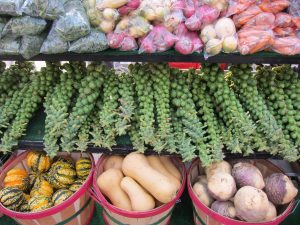 Written by Leila G., UNH Dietetic Intern
Written by Leila G., UNH Dietetic Intern
Turkey! Mashed Potatoes! Pumpkin Pie! Oh my!
It’s that time of year again: Thanksgiving.
Certainly, this has been an unexpected year for all of us. Despite that the holidays may look a little different this year, hopefully, we are able to gather around the table with our loved ones and give thanks for all of our blessings.
We all have our own unique holiday traditions. Some of us may spend Thanksgiving with family. Some of us spend it with friends. Some of us may eat in the early afternoon, and some of us eat late at night. Some of us may even add our own cultural spin on the foods we serve and eat! The one thing that we all share in common, however, is a Thanksgiving meal. Although turkey is usually the star of the show, it’s the side dishes that really amp up the feast. Filling the table with delicious and nutritious side dishes will make for a wonderful meal as well as lots of different flavors! Incorporating seasonally available produce specifically into our recipes has many benefits:
- Eating seasonally available produce improves your nutrient intake and allows you to enjoy it at its optimal harvest.
- Purchasing produce seasonally saves you money and benefits the environment.
- Buying produce from a farmer’s market, farm stand, or Community Supported Agriculture (CSA), allows you to form a closer connection to where your food is coming from and benefits the community as a whole.
Below are 5 seasonal side recipes you can try at home! Nutritional benefits are highlighted along with simple tips and tricks to up your nutrient intake, while still enjoying a tasty dish!
Beets are an excellent source of phytochemicals, antioxidants like betalains and carotenoids, and inorganic nitrates and nitrites, all which have unique health benefits. This root vegetable is also a good source of dietary fiber, folate, and potassium. Beets can be enjoyed many different ways. When they are roasted, they have a much sweeter flavor. Try roasting smaller, cubed beets and adding salad greens, red onion, lemon, honey, fresh thyme, and walnuts to create a delicious winter side salad!
Green beans are rich in vitamin A, which helps with vision and vitamin K, which improves bone health and blood clotting. They are also a great source of vitamin C, which aids in wound healing and maintaining healthy skin. When possible, it’s better to use fresh or frozen green beans as they provide a better source of nutrients than canned green beans. If you do end up using canned green beans, make sure to rinse and drain them – this will reduce the sodium content! Choose low-fat milk for this recipe and if time permits, consider making homemade crispy onions using whole wheat bread crumbs, olive or canola oil, and your own amounts of seasoning!
It’s a common misconception that potatoes are not healthy for us, especially with the recent fad of low-carb diets.This myth is likely because most of the time, potatoes are cooked or eaten with large amounts of butter and sour cream. However, on their own, potatoes are pretty low in calories and provide us with a variety of nutrients that are preventative against chronic diseases. They are an excellent source of potassium, a major player in maintaining healthy blood pressure, along with many other vitamins and minerals. Try substitutions like plant-based butter and low-fat milk and cheese when making this dish!
Butternut squash is a seasonal favorite among many – it’s low in calories and loaded with vitamins A and C. Peeling and seeding a butternut squash is quite simple and doesn’t take too long! There are many tutorials online showing instructions. Try tossing cubed butternut squash with olive oil, maple syrup, cinnamon, and a little bit of salt to create a sweet, yet savory side dish. And since butternut squash is naturally sweet, you only need to add minimal amounts of maple syrup! Kick up the flavor by adding a pinch of cayenne pepper or paprika.
Kale is a dark leafy green vegetable and like green beans, is also an excellent source of vitamin A and vitamin K. In fact, one cup of raw kale has more vitamin A and vitamin K than you need in an entire day! It’s considered a superfood because of all the brain-boosting nutrients and antioxidants it contains. Adding kale or another leafy green to your stuffing will increase its nutritional value and add a unique flavor sure to please your friends and family! Use olive or canola oil instead of butter to include more healthy fats instead of unhealthy fats for this recipe.
https://www.todaysdietitian.com/newarchives/0220p26.shtml
https://www.medicalnewstoday.com/articles/285753
https://www.medicalnewstoday.com/articles/280579#nutritional_profile
https://www.hsph.harvard.edu/nutritionsource/food-features/kale/
